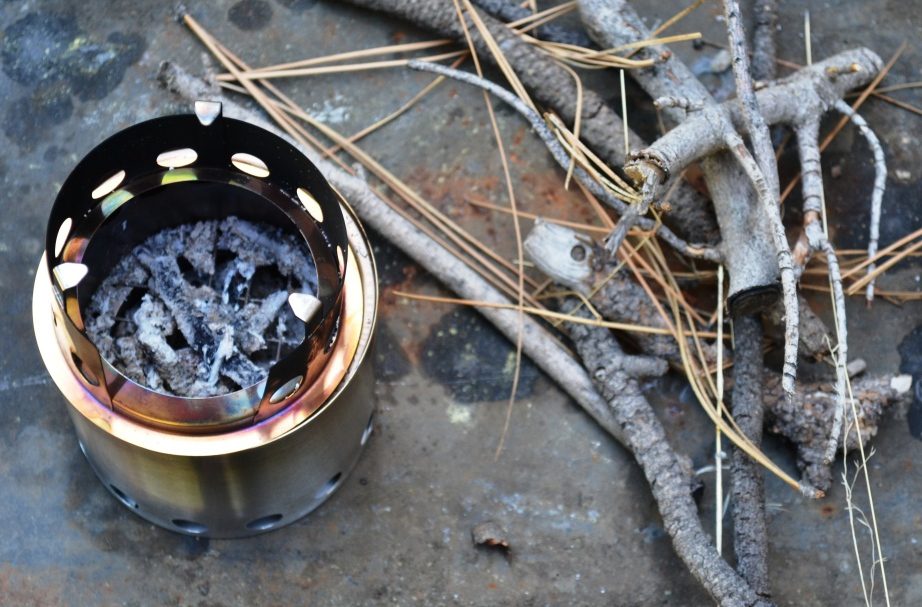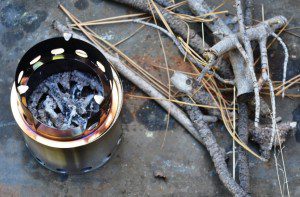The quest for a reliable, easy-to-use backpacking stove never ends, and I have the collection to prove it!
But the Solo Stove is really impressive, and worth taking a look at.
(Disclaimer: This review is my opinion. I was not reimbursed for doing this review, nor does Solo Stove at the time of this review, advertise on SurvivalCommonSense.com or any of its affiliates.)
by Leon Pantenburg
I’m caught in the baby-boomer backpacker quandary. On one hand, I like gear that works, and proven items are hard to leave behind. But my aging, abused knees make going light mandatory. I’ve had to replace effective, proven gear strictly on the basis of weight.
The Solo Stove specifications: Boiling: 8-10 minutes to boil 34 fl oz of water; Fuel: Burns sticks, pine cones and other biomass; Packed size: Height 3.8 inches, Width 4.25 inches; Assembled size: Height 5.7 inches, Width 4.25 inches; Weight: 9 oz; Materials: Hardened 304 stainless steel, nichrome wire
But some things you can’t lighten up and one of those is stove fuel. It is heavy and if you run out in the wilderness, your stove becomes dead weight.
Here’s my stove philosophy: You don’t need much. Probably 90 percent of the time, all a backpacker requires is boiling water to brew tea or coffee or rehydrate food.
So the idea of a lightweight backpacking stove, with no moving parts, that burns twigs, pine cones, sticks etc is very attractive. So, I contacted Solo Stove to do a test and review. (Check out my Solo Stove test video below!)
My stove arrived in the mail a few days later, and first impressions were very positive. The stove fits perfectly inside my standard carry 42-ounce enamelware cup, and nesting the Solo Stove inside was a no-brainer.
Workmanship is superb. The Solo Stove is well-built and made of heavy gauge stainless steel with no seams, but it only weighs nine ounces. There are no parts to break or ports or vents to clog.
The Solo Stove is a natural convection inverted downgas gasifer stove, according to the company website, that incorporates a secondary combustion for a more efficient and cleaner burn. The bottom vents allow air to enter and flow up the bottom of the grate to feed the primary combustion, a top down smolder. In addition, air entering from the bottom vents heats up within the inner wall and rises up and out the top firebox vents causing a secondary combustion at the top of the stove.
The Solo Stove doesn’t just burn wood, according to the website, but actually cooks the smoke out of the wood and then burns the smoke twice. This technique makes for a cleaner burn, the company claims, which means less smoke. This would also allow the stove to burn more efficiently which means it requires less fuel.
Anyway, all this hyperbole is shinola unless the stove works, so I set out to do some testing.
The first item was fuel. I took a stroll in the pine forest behind my house and gathered biomass stuff. This included damp and decaying sticks and twigs and a few pine cones. I grabbed a big handful.
I lighted the stove with a cotton ball and petroleum jelly, ignited with a ferro rod. The stove lighted very easily, and all it took was a few twigs to get a blaze going. I broke the twigs into small pieces and loaded the stove, and in no time, I had a blaze going. The top was just right to put that 42-ounce cup on, and everything balanced well.
I fed the fire through the slot in the side of the top, and in a few minutes, had boiling water. A Jetboil could have done the job a few minutes faster, but so what?
The only downside I can see is the inevitable wood soot buildup on cooking utensils. But you know that going in. The best idea is to make a separate bag or container for the cooking utensil, and segregate it from the rest of your gear. Or, you can cover the utensil bottom with aluminum foil before cooking.
Based on my testing so far, I really like the Solo Stove. With Coleman gas hitting over $12 per gallon here at the Walmart, fuel cost savings could be considerable. And the fuel is never going to get any lighter.
A biomass stove that can take advantage of easily-obtainable fuel is something all of us backpackers should be looking at. I’ve got a backpack trip scheduled for the middle of July, and the Solo Stove will be going along.
Please click here to check out and subscribe to the SurvivalCommonSense.com YouTube channel – thanks!




Leave a Reply